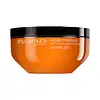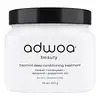What's inside
What's inside
 Key Ingredients
Key Ingredients

No key ingredients
 Benefits
Benefits

 Concerns
Concerns

 Ingredients Side-by-side
Ingredients Side-by-side

Water
Skin ConditioningCetearyl Alcohol
EmollientBehentrimonium Chloride
PreservativeGlycerin
HumectantAmodimethicone
Cetyl Esters
EmollientPotato Starch Modified
Isopropyl Alcohol
SolventMethylparaben
PreservativeTrideceth-6
EmulsifyingTocopherol
AntioxidantGlycine Soja Oil
EmollientChlorhexidine Dihydrochloride
AntimicrobialCetrimonium Chloride
AntimicrobialAlcohol
AntimicrobialSafflower Glucoside
Hexyl Cinnamal
PerfumingHydroxycitronellal
PerfumingPhenoxyethanol
PreservativeSodium Hydroxide
BufferingGentiana Lutea Root Extract
Skin ConditioningMoringa Oleifera Seed Extract
Skin ConditioningCorallina Officinalis Extract
Skin ConditioningDisodium Phosphate
BufferingCitric Acid
BufferingBHT
AntioxidantSodium Citrate
BufferingParfum
MaskingWater, Cetearyl Alcohol, Behentrimonium Chloride, Glycerin, Amodimethicone, Cetyl Esters, Potato Starch Modified, Isopropyl Alcohol, Methylparaben, Trideceth-6, Tocopherol, Glycine Soja Oil, Chlorhexidine Dihydrochloride, Cetrimonium Chloride, Alcohol, Safflower Glucoside, Hexyl Cinnamal, Hydroxycitronellal, Phenoxyethanol, Sodium Hydroxide, Gentiana Lutea Root Extract, Moringa Oleifera Seed Extract, Corallina Officinalis Extract, Disodium Phosphate, Citric Acid, BHT, Sodium Citrate, Parfum
Water
Skin ConditioningButyrospermum Parkii Butter
Skin ConditioningCocos Nucifera Oil
MaskingBehentrimonium Methosulfate
Cetearyl Alcohol
EmollientCetyl Alcohol
EmollientGlycerin
HumectantGlyceryl Stearate
EmollientAdansonia Digitata Oil
EmollientPrunus Amygdalus Dulcis Oil
Skin ConditioningOpuntia Ficus-Indica Seed Oil
EmollientCetyl Esters
EmollientHydrolyzed Wheat Protein
Skin ConditioningCetrimonium Chloride
AntimicrobialBiotin
AntiseborrhoeicGuar Hydroxypropyltrimonium Chloride
Skin ConditioningCucurbita Pepo Seed Oil
EmollientCaprylyl Glycol
EmollientPhenoxyethanol
PreservativeGaultheria Procumbens Leaf Oil
MaskingMentha Piperita Oil
MaskingMentha Viridis Leaf Oil
AstringentQuaternium-80
Lavandula Spica Herb Oil
PerfumingRosmarinus Officinalis Leaf Oil
MaskingMenthol
MaskingWater, Butyrospermum Parkii Butter, Cocos Nucifera Oil, Behentrimonium Methosulfate, Cetearyl Alcohol, Cetyl Alcohol, Glycerin, Glyceryl Stearate, Adansonia Digitata Oil, Prunus Amygdalus Dulcis Oil, Opuntia Ficus-Indica Seed Oil, Cetyl Esters, Hydrolyzed Wheat Protein, Cetrimonium Chloride, Biotin, Guar Hydroxypropyltrimonium Chloride, Cucurbita Pepo Seed Oil, Caprylyl Glycol, Phenoxyethanol, Gaultheria Procumbens Leaf Oil, Mentha Piperita Oil, Mentha Viridis Leaf Oil, Quaternium-80, Lavandula Spica Herb Oil, Rosmarinus Officinalis Leaf Oil, Menthol
Ingredients Explained
These ingredients are found in both products.
Ingredients higher up in an ingredient list are typically present in a larger amount.
Cetearyl alcohol is a mixture of two fatty alcohols: cetyl alcohol and stearyl alcohol. It is mainly used as an emulsifier. Emulsifiers help prevent the separation of oils and products. Due to its composition, it can also be used to thicken a product or help create foam.
Cetearyl alcohol is an emollient. Emollients help soothe and hydrate the skin by trapping moisture.
Studies show Cetearyl alcohol is non-toxic and non-irritating. The FDA allows products labeled "alcohol-free" to have fatty alcohols.
This ingredient is usually derived from plant oils such as palm, vegetable, or coconut oils. There is debate on whether this ingredient will cause acne.
Due to the fatty acid base, this ingredient may not be Malassezia folliculitis safe.
Learn more about Cetearyl AlcoholThis ingredient is a preservative, antimicrobial, and emulsifier. It is often used in cosmetics for its ability to cleanse, condition, and reduce static.
Cetrimonium chloride is a quaternary ammonium salt, meaning it has a water-soluble structure.
Cetyl Esters is a synthetic wax made up of mostly fatty acids and fatty alcohols. It is strcturally similar to wax taken from whales.
As an emollient, it creates a thin barrier on the skin. This barrier prevents moisture from escaping.
This ingredient may not be fungal-acne safe.
Learn more about Cetyl EstersGlycerin is already naturally found in your skin. It helps moisturize and protect your skin.
A study from 2016 found glycerin to be more effective as a humectant than AHAs and hyaluronic acid.
As a humectant, it helps the skin stay hydrated by pulling moisture to your skin. The low molecular weight of glycerin allows it to pull moisture into the deeper layers of your skin.
Hydrated skin improves your skin barrier; Your skin barrier helps protect against irritants and bacteria.
Glycerin has also been found to have antimicrobial and antiviral properties. Due to these properties, glycerin is often used in wound and burn treatments.
In cosmetics, glycerin is usually derived from plants such as soybean or palm. However, it can also be sourced from animals, such as tallow or animal fat.
This ingredient is organic, colorless, odorless, and non-toxic.
Glycerin is the name for this ingredient in American English. British English uses Glycerol/Glycerine.
Learn more about GlycerinPhenoxyethanol is a preservative that has germicide, antimicrobial, and aromatic properties. Studies show that phenoxyethanol can prevent microbial growth. By itself, it has a scent that is similar to that of a rose.
It's often used in formulations along with Caprylyl Glycol to preserve the shelf life of products.
Water. It's the most common cosmetic ingredient of all. You'll usually see it at the top of ingredient lists, meaning that it makes up the largest part of the product.
So why is it so popular? Water most often acts as a solvent - this means that it helps dissolve other ingredients into the formulation.
You'll also recognize water as that liquid we all need to stay alive. If you see this, drink a glass of water. Stay hydrated!
Learn more about Water